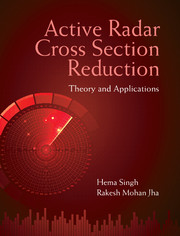Book contents
- Frontmatter
- Dedication
- Contents
- List of Tables
- List of Figures
- List of Abbreviations
- Preface
- Acknowledgements
- 1 Introduction to Radar Cross Section Reduction
- 2 RAM Analysis for Low-Observable Platforms
- 3 Radar Cross Section of Phased Antenna Arrays
- 4 Active RCS Reduction in Phased Arrays
- 5 Mutual Coupling Effects in Phased Arrays
- 6 RCS of Dipole Array Including Mutual Coupling Effects
- 7 Performance of Sidelobe Cancellers in Active RCSR
- 8 Emerging RCSR Techniques
- Epilogue
- Appendices
- List of Symbols
- Suggestions for Further Reading
- Author Index
- Subject Index
Epilogue
Published online by Cambridge University Press: 05 April 2015
- Frontmatter
- Dedication
- Contents
- List of Tables
- List of Figures
- List of Abbreviations
- Preface
- Acknowledgements
- 1 Introduction to Radar Cross Section Reduction
- 2 RAM Analysis for Low-Observable Platforms
- 3 Radar Cross Section of Phased Antenna Arrays
- 4 Active RCS Reduction in Phased Arrays
- 5 Mutual Coupling Effects in Phased Arrays
- 6 RCS of Dipole Array Including Mutual Coupling Effects
- 7 Performance of Sidelobe Cancellers in Active RCSR
- 8 Emerging RCSR Techniques
- Epilogue
- Appendices
- List of Symbols
- Suggestions for Further Reading
- Author Index
- Subject Index
Summary
The main objective of this book is to establish the feasibility of a novel concept of active radar cross section reduction (RCSR). In this context, the phased antenna array theory and algorithms are discussed.
A discerning reader may conclude that this book does not directly lead to the realisation of low-observable platforms, which is correct. The book in hand is not a handbook or a reference manual for achieving active RCSR over low-observable platforms.
Design and realisation of active RCS low-observable platforms through this route (i.e. the theory and algorithms of phased antenna arrays) would also involve on-board/airborne antenna analysis. As mentioned in the Preface of this book, the methods and techniques for on-board/airborne antenna analysis are now well-established across all the three (low, resonance and high) frequency regions. References are numerous and readers may have their own preferences.
Another important aspect is that of conformal arrays. Again, the modern conformal antenna theory now appears to have been systematised (Josefsson and Persson, 2006). Incidentally, the analytical core of the conformal array theory in this reference (Josefsson and Persson, 2006) relies extensively on the work of one of the authors (Jha et al. 1993), (Jha et al. 1994) or (Jha and Wiesbeck, 1995). Analysis of conformal phased arrays over the airborne platform would be required towards achieving the low-observable platform. The conformal antenna array RCS is summed up with the structural RCS of the platform to obtain a quiescent RCS pattern. Following the sensing of the direction of arrival (DOA) of the incoming radar wave, the overall structural plus antenna mode RCS pattern is adapted to obtain the active RCSR in the DOA, thereby leading to the active low-observable platform.
It may be noted that other techniques to realise low-observable platforms are also prevalent and have been discussed in this book. Broadbanding of RCSR is important and the basic theory of RAM design (Vinoy and Jha 1996) should not be lost sight of. Likewise, plasma stealth is emerging as yet another feasible option in the context of low-observable platforms.
- Type
- Chapter
- Information
- Active Radar Cross Section ReductionTheory and Applications, pp. 283 - 284Publisher: Cambridge University PressPrint publication year: 2015



